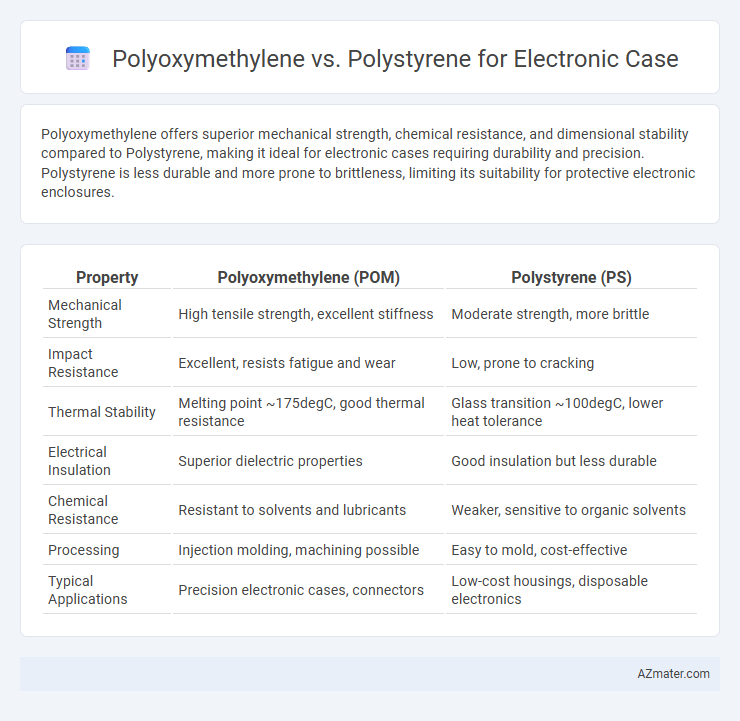Polyoxymethylene offers superior mechanical strength, chemical resistance, and dimensional stability compared to Polystyrene, making it ideal for electronic cases requiring durability and precision. Polystyrene is less durable and more prone to brittleness, limiting its suitability for protective electronic enclosures.
Table of Comparison
| Property | Polyoxymethylene (POM) | Polystyrene (PS) |
|---|---|---|
| Mechanical Strength | High tensile strength, excellent stiffness | Moderate strength, more brittle |
| Impact Resistance | Excellent, resists fatigue and wear | Low, prone to cracking |
| Thermal Stability | Melting point ~175degC, good thermal resistance | Glass transition ~100degC, lower heat tolerance |
| Electrical Insulation | Superior dielectric properties | Good insulation but less durable |
| Chemical Resistance | Resistant to solvents and lubricants | Weaker, sensitive to organic solvents |
| Processing | Injection molding, machining possible | Easy to mold, cost-effective |
| Typical Applications | Precision electronic cases, connectors | Low-cost housings, disposable electronics |
Introduction to Polyoxymethylene and Polystyrene
Polyoxymethylene (POM), also known as acetal, is a high-performance engineering thermoplastic renowned for its excellent mechanical strength, dimensional stability, and low friction properties, making it ideal for precision electronic cases requiring durability. Polystyrene (PS), a versatile and cost-effective thermoplastic, offers ease of molding and good insulating properties but lacks the mechanical robustness and chemical resistance of POM. Electronic cases made from POM benefit from enhanced impact resistance and thermal stability, whereas polystyrene is more suited for lightweight, economical applications with less demanding structural requirements.
Material Composition and Properties
Polyoxymethylene (POM) is a crystalline thermoplastic known for its high stiffness, low friction, and excellent dimensional stability, making it ideal for durable electronic cases that require precision and wear resistance. Polystyrene (PS) is an amorphous polymer valued for its ease of molding, good insulating properties, and cost-effectiveness but exhibits lower mechanical strength and impact resistance compared to POM. The semi-crystalline structure of POM provides superior chemical resistance and thermal stability up to 120degC, whereas PS tends to degrade at lower temperatures and is more brittle under mechanical stress.
Mechanical Strength Comparison
Polyoxymethylene (POM) exhibits superior mechanical strength compared to polystyrene (PS), making it more suitable for electronic cases requiring high durability and impact resistance. POM features a tensile strength of approximately 70 MPa and excellent fatigue resistance, while polystyrene typically has a lower tensile strength around 40 MPa and is more brittle under stress. The higher flexural modulus and toughness of POM ensure better performance in protecting delicate electronic components from mechanical shocks and stresses.
Electrical Insulation Capabilities
Polyoxymethylene (POM) offers superior electrical insulation capabilities due to its high dielectric strength and low electrical conductivity, making it ideal for electronic cases requiring reliable insulation against electrical currents. Polystyrene (PS), while providing moderate insulation, typically exhibits lower dielectric strength and is more prone to static buildup, which can compromise sensitive electronic components. For electronic casings where electrical insulation performance is critical, POM's superior resistance to electrical breakdown ensures enhanced safety and device longevity.
Thermal Stability and Heat Resistance
Polyoxymethylene (POM) exhibits superior thermal stability and heat resistance compared to polystyrene, making it more suitable for electronic cases exposed to elevated temperatures. POM maintains structural integrity and resists deformation up to approximately 120degC, whereas polystyrene tends to soften and warp around 75-100degC. The higher melting point and better dimensional stability of POM enhance the durability and safety of electronic enclosures under thermal stress.
Chemical Resistance in Electronics Environments
Polyoxymethylene (POM) exhibits superior chemical resistance compared to polystyrene (PS) in electronics environments, effectively withstanding exposure to solvents, cleaning agents, and oils commonly found in electronic assemblies. Its high crystallinity and strong molecular bonds prevent degradation, ensuring durability and longevity in harsh chemical conditions. Polystyrene, although cost-effective, tends to absorb chemicals and degrade faster, making it less suitable for applications requiring robust chemical resistance in electronic cases.
Processing and Manufacturability
Polyoxymethylene (POM) offers superior dimensional stability and low moisture absorption, making it ideal for electronic cases requiring precise tolerances and durability during processing. Polystyrene (PS) provides easier and faster injection molding with lower processing temperatures, but it is more brittle and prone to warping, limiting its manufacturability for high-impact or heat-sensitive applications. POM's higher melting point and excellent wear resistance enable complex, high-performance electronic housings, while PS suits cost-sensitive projects with simpler design requirements.
Cost Analysis and Market Availability
Polyoxymethylene (POM) offers superior mechanical strength and dimensional stability for electronic cases but is generally more expensive than Polystyrene (PS), which provides lower manufacturing costs due to its simpler processing. Market availability favors Polystyrene as it is widely produced and readily accessible globally, while Polyoxymethylene, though available, is often sourced from specialized suppliers leading to higher lead times and price volatility. Cost analysis reveals that Polystyrene is optimal for high-volume, low-cost applications, whereas Polyoxymethylene suits premium or high-performance electronic enclosures where durability justifies the added expense.
Environmental Impact and Recyclability
Polyoxymethylene (POM) offers superior recyclability compared to polystyrene (PS) due to its thermoplastic nature, allowing it to be melted and remolded multiple times without significant degradation. Polystyrene, often used in electronic cases for its lightweight and insulating properties, poses greater environmental challenges because it is less biodegradable and more difficult to recycle, frequently ending up in landfills or causing microplastic pollution. Choosing POM for electronic cases reduces environmental impact through better material recovery and lower long-term waste accumulation.
Best Use Cases for Electronic Device Housings
Polyoxymethylene (POM) offers exceptional dimensional stability, high impact resistance, and low friction, making it ideal for electronic device housings requiring precise mechanical parts and robust structural support. Polystyrene (PS), characterized by its ease of molding and excellent electrical insulating properties, suits cost-effective consumer electronics with simple design requirements and minimal mechanical stress. Selecting POM benefits devices needing durability and tight tolerances, while PS fits applications prioritizing aesthetics and budget constraints in electronic cases.

Infographic: Polyoxymethylene vs Polystyrene for Electronic Case
 azmater.com
azmater.com